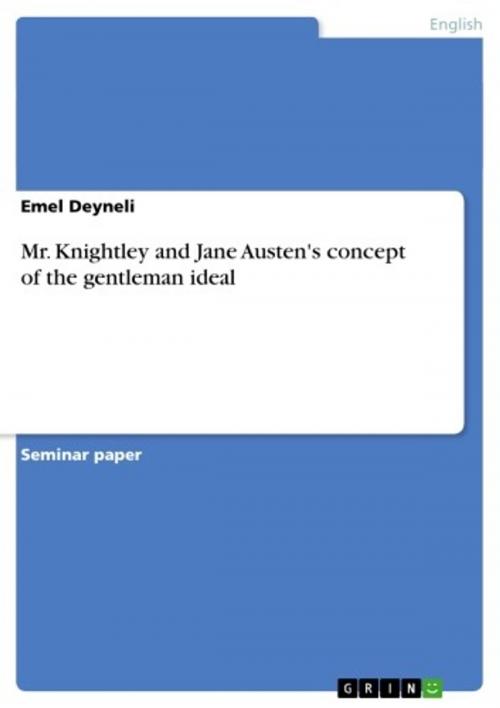Mr. Knightley and Jane Austen's concept of the gentleman ideal
Fiction & Literature, Literary Theory & Criticism, British| Author: | Emel Deyneli | ISBN: | 9783638210324 |
| Publisher: | GRIN Publishing | Publication: | August 5, 2003 |
| Imprint: | GRIN Publishing | Language: | English |
| Author: | Emel Deyneli |
| ISBN: | 9783638210324 |
| Publisher: | GRIN Publishing |
| Publication: | August 5, 2003 |
| Imprint: | GRIN Publishing |
| Language: | English |
Seminar paper from the year 2003 in the subject English Language and Literature Studies - Literature, grade: 2 (B), University of Marburg (Anglistics), course: SE: Jane Austen, 11 entries in the bibliography, language: English, abstract: Jane Austen was born on 16 December 1775 at Steventon, near Basingstoke, the seventh child of the rector of the parish. She began to write stories wen she was a girl, but only four of her novels were published during her lifetime.1 Among them was Emma published in the year 1816. Although Jane Austen chooses women as her heroines, there are also different types of men represented. They extend from the villain to the polite gentleman. The following term paper will try to examine Jane Austen's gentleman ideal in her novel Emma with a representative English gentleman. This is Mr. George Knightley. The virtues that Emma praises in Robert Martin's letter are all those which can be associated with the traditional age of chivalry: There were merely no grammatical errors, but as a composition it would not have disgraced a gentleman; the language, though plain, was strong and unaffected, and the sentiments it conveyed very much to the credit of the writer. It was short, but expressed good sense, warm attachment, liberality, propriety, even delicacy of feeling.2 The name 'Knightley' reveals already parts of the meaning. It contains the word 'knight' who used to play an important role in Chaucer's poetry. In Chaucer's knight and Squire, for instance, is the knightly honour represented and Mr.Knightley embodies this. However, Jane Austen takes Chaucer's knight with his characteristics as a point of departure but she modernizes this image. While honourable young men dedicated themselves to courtly love, they do not so in Jane Austen's novels. Mr. Knightley as the representative English gentleman in the novel Emme will be looked at and analysed throughout the novel. The main emphasis will be in his development from the beginning till the end and the characteristics which make him a gentleman.
Seminar paper from the year 2003 in the subject English Language and Literature Studies - Literature, grade: 2 (B), University of Marburg (Anglistics), course: SE: Jane Austen, 11 entries in the bibliography, language: English, abstract: Jane Austen was born on 16 December 1775 at Steventon, near Basingstoke, the seventh child of the rector of the parish. She began to write stories wen she was a girl, but only four of her novels were published during her lifetime.1 Among them was Emma published in the year 1816. Although Jane Austen chooses women as her heroines, there are also different types of men represented. They extend from the villain to the polite gentleman. The following term paper will try to examine Jane Austen's gentleman ideal in her novel Emma with a representative English gentleman. This is Mr. George Knightley. The virtues that Emma praises in Robert Martin's letter are all those which can be associated with the traditional age of chivalry: There were merely no grammatical errors, but as a composition it would not have disgraced a gentleman; the language, though plain, was strong and unaffected, and the sentiments it conveyed very much to the credit of the writer. It was short, but expressed good sense, warm attachment, liberality, propriety, even delicacy of feeling.2 The name 'Knightley' reveals already parts of the meaning. It contains the word 'knight' who used to play an important role in Chaucer's poetry. In Chaucer's knight and Squire, for instance, is the knightly honour represented and Mr.Knightley embodies this. However, Jane Austen takes Chaucer's knight with his characteristics as a point of departure but she modernizes this image. While honourable young men dedicated themselves to courtly love, they do not so in Jane Austen's novels. Mr. Knightley as the representative English gentleman in the novel Emme will be looked at and analysed throughout the novel. The main emphasis will be in his development from the beginning till the end and the characteristics which make him a gentleman.















